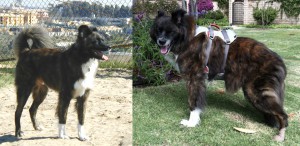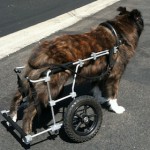April 25, 2012
When our dogs get older, they start showing all sorts of health problems, just like the way we do. One of the typical issues with large dogs is their weakening back ends. When their hips or spinal nerves deteriorate, dogs typically start dragging their feet/paws. Consequently, their toe nails get worn out and eventually start bleeding.
I wrote about my dog, Valentino in another article, “Your aging dog” last November. Knock on wood, he’s still in good spirits and can walk a mile on good days, although very wobbly and needs my assistance with slings and harnesses — using different ones for different terrains.
While there are many wonderful products that help you care for your aging dogs, you often run into unique situations for which no products are available, and you have to come up with something on your own.
My late dog, Forte had degenerative myelopathy, and he was on a “wheelchair” after he became paralyzed from the waist down. During this period, I had to be creative with his diapers because this 120-pounder was such a big dog and no doggie diaper was large enough to fit him. I bought diapers for human seniors, and used two of them to cover his rear, one of which, I had to cut out a hole for his tail. To keep him clean, I had to change them every two hours or so.
When Valentino started shuffling his hind paws, I noticed that the skin on his paws was getting smooth, which meant they were getting thin and would eventually cause abrasions. I also started hearing his toe nails scratching the ground. This was the time I knew that he needed “shoes” to protect his paws and toes before his nails get worn out.
Some people stop walking their dogs at this stage, but that would only create atrophies and your dog’s condition deteriorates much faster. So, this is not the time to give up on your dog.
I first tried all sorts of doggie booties, from the softest to the kind that Search & Rescue dogs wear on the rubble. None of them worked for him because they were rather cumbersome, and he started walking awkwardly which threw his hips out. I concluded that these boots are made for healthy dogs who run around on rough trains or in the snow. But not for an old man like Valentino who can barely lift his legs.
One of the newer products is the booties made of rubber, which look like a thick balloon. These are reusable and disposable booties. I’ve seen them on many dogs when I took Valentino to his therapy center, but the opening of each bootie is so tight that I was concerned about cutting off the circulation in his legs, even though veterinarians say that it’s safe enough because you are using them only on walks and not for long hours. I also found it almost impossible to put them on my dog by myself because you need to stretch the opening with both hands and stick your dog’s paw in it, which your dog would not voluntarily do, so you need another hand to hold his leg and put it through the opening.
My other dog, Pollyanna has a condition called, symmetrical lipoid onychodystrophy, which separates the quick from the nail. Thankfully, she’s in remission, but I used to wrap her paws with bandages, like Vetrap and SyrFlex. So, I tried using them for Valentino, and voila, they worked.

When he was wearing the commercially available booties, he used to trip on the edges of the booties, but since the bandages are perfectly molded to his paws, he has the normal clearance around his footwork. As an added benefit, I found out that while he can move his legs flexibly, by bandaging them, it gives the support for his paws through hocks and helps him with more stability.
It took me a while to come up with the best way of wrapping his paws, adding extra padding for the toe nails, so that they wouldn’t stick out and get worn out. It’s a bit of extra work because I have to bandage him every time we step out, as I have to remove and discard them after each walk. But you get used to it and before you know, you become a pro!
I also consider these moments as our additional bonding experience. He knows exactly what I’m doing for him, so he patiently stays still and gives me a soft kiss when he’s all nicely wrapped up and we’re ready to go.
It costs about $40 per month as you go through about a roll of bandage a day, and it’s well worth it. Almost all large dogs end up having weak hind legs when they get old, and the discovery of this bandage method was a godsend to me, or to my dog; and hopefully to other dogs whose guardians may be reading this article.

Marie Atake is Founder & President of Forte Animal Rescue and a former Commissioner on the Board of L.A. Animal Services.






